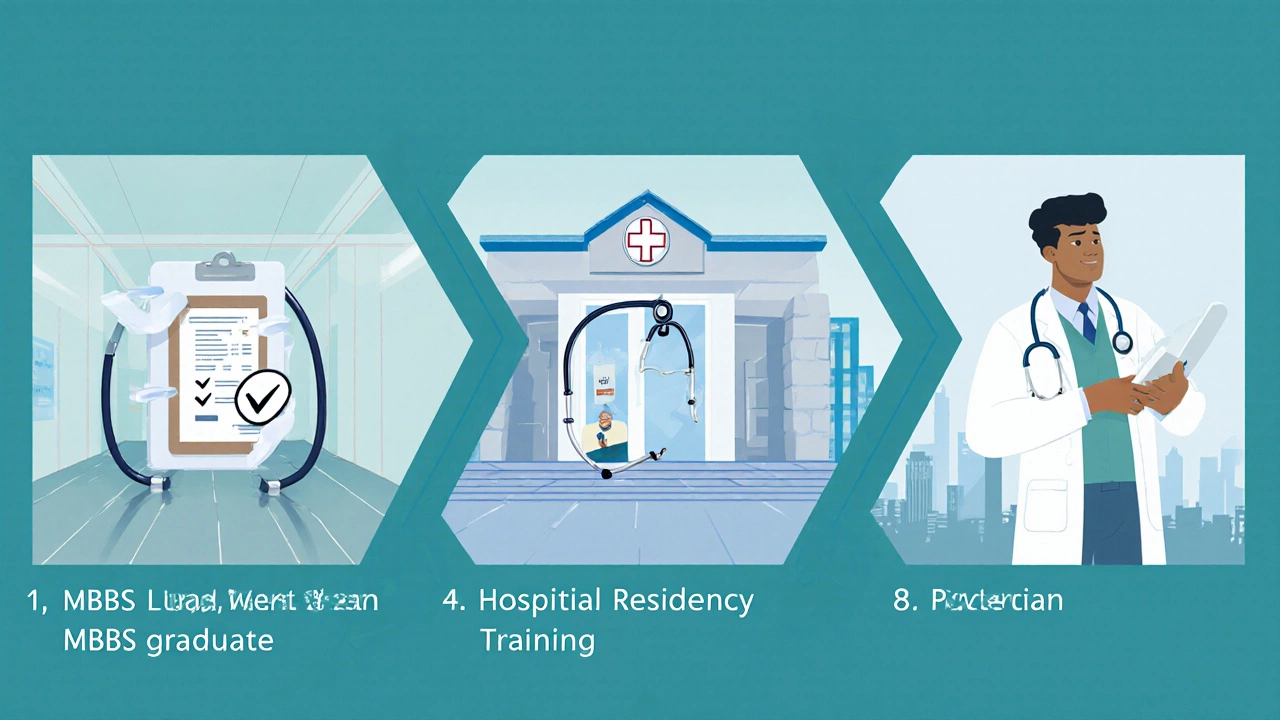U.S. Doctor Salary Calculator
When an Indian MBBS doctor is eyeing a career in the United States, the first question is usually the paycheck.
What does "MBBS" mean in the American context?
In India, a MBBS (Bachelor of Medicine, Bachelor of Surgery) is the primary medical qualification. The United States, however, does not award an MBBS degree; instead it issues an MD (Doctor of Medicine) . To practice, an Indian graduate must convert the MBBS credential into a U.S. Medical License, which involves passing the USMLE, completing a residency, and often obtaining a J‑1 or H‑1B visa.
Pathway from MBBS to a paying U.S. medical job
The journey can be split into three milestones:
- USMLE (United States Medical Licensing Examination): Consists of Step 1, Step 2 CK, and Step 2 CS (currently suspended). A total score above 240 usually makes a candidate competitive for residency.
- Residency program: After a successful match through the NRMP (National Resident Matching Program), the graduate spends 3‑7 years training in a chosen specialty. Residency salaries are modest (about $65,000 - $70,000 per year in 2025) but are the gateway to full licensure.
- Full licensure and board certification: Once residency is completed, doctors obtain a state medical license and can practice independently, earning the salaries discussed below.
Each step adds costs (exam fees, travel, living expenses) that can total $30,000 - $50,000 before a doctor even sees a full‑time paycheck.
MBBS doctor salary USA - the numbers you need
The American Medical Association (AMA) publishes annual compensation data. In 2025, the median annual salary for all physicians (MD or DO) is $284,000. However, salaries vary wildly by specialty, location, and practice setting.
| Specialty | Average Salary | Median Salary | Typical Range |
|---|---|---|---|
| Family Medicine | $230,000 | $225,000 | $190,000 - $260,000 |
| Internal Medicine | $250,000 | $245,000 | $210,000 - $300,000 |
| General Surgery | $322,000 | $315,000 | $260,000 - $385,000 |
| Orthopedic Surgery | $511,000 | $500,000 | $420,000 - $620,000 |
| Radiology | $489,000 | $475,000 | $410,000 - $560,000 |
| Dermatology | $458,000 | $445,000 | $380,000 - $540,000 |
| Neurosurgery | $720,000 | $710,000 | $620,000 - $860,000 |
For an MBBS graduate entering the U.S. system, the realistic starting point after residency (around year 5‑7 of training) is the median salary for the chosen specialty. A family medicine doctor in a mid‑size city can expect ~ $225k, while a surgeon in a high‑cost market may start nearer $400k.

Key factors that shift the paycheck
- Geography: States with higher cost‑of‑living indices (California, New York, Massachusetts) tend to pay 10‑20% more to offset expenses. The Cost of Living Index shows Seattle at 128 (U.S. average = 100) while Dallas sits at 95.
- Practice setting: Hospital‑employed physicians often receive a lower base salary but get benefits and bonus structures. Private‑practice owners can earn more after overhead, but must manage staff, rent, and insurance.
- Experience: Each additional year after board certification typically adds 3‑5% to the base salary.
- Sub‑specialization: Adding a fellowship (e.g., interventional cardiology) can increase earnings by $50k‑$150k annually.
- Negotiation and contracts: Physicians who hire professional negotiators often lock in higher signing bonuses and better call‑out pay.
How to boost your earnings as an MBBS‑to‑MD convert
- Target high‑pay specialties early. While primary care is noble, fields like orthopedics or radiology consistently outrank others.
- Consider geographic flexibility. Moving to a region with physician shortages (e.g., rural Midwest) can net sign‑on bonuses up to $100k.
- Secure a fellowship. A one‑year fellowship in a niche area can raise your market value dramatically.
- Leverage moonlighting. Many residents and early‑career doctors take extra shifts, adding $20k‑$40k per year.
- Invest in leadership roles. Directorships or department chair positions carry administrative stipends.
Quick checklist for Indian MBBS graduates planning a U.S. medical career
- Pass USMLE Step 1 with a score >240.
- Complete Step 2 CK (and the optional Step 2 CS if reinstated).
- Obtain ECFMG certification - the gateway to residency applications.
- Apply through the NRMP and secure a residency match.
- Finish residency (3‑7 years) and obtain a state medical license.
- Choose a specialty based on salary goals, lifestyle, and interest.
- Negotiate contract terms, sign‑on bonuses, and relocation assistance.
Frequently Asked Questions
Can an MBBS graduate work as a doctor in the U.S. without completing a residency?
No. The U.S. requires completion of an accredited residency program before granting a full medical license, even if the physician holds an MBBS degree.
What is the average starting salary after residency?
For 2025, the average starting salary across specialties is roughly $230,000 - $260,000, with primary‑care fields on the lower end and surgical specialties on the higher end.
How does cost of living affect my take‑home pay?
Higher‑cost cities often offer 10‑20% higher salaries, but after accounting for housing, taxes, and transportation, net disposable income can be similar to lower‑cost areas. Use a cost‑of‑living calculator to compare.
Is a signing bonus common?
Yes, especially for in‑demand specialties or underserved locations. Bonuses range from $10,000 to $100,000.
How long does the entire process take?
From the first USMLE step to the end of residency, expect 5 - 10 years, depending on specialty length.











